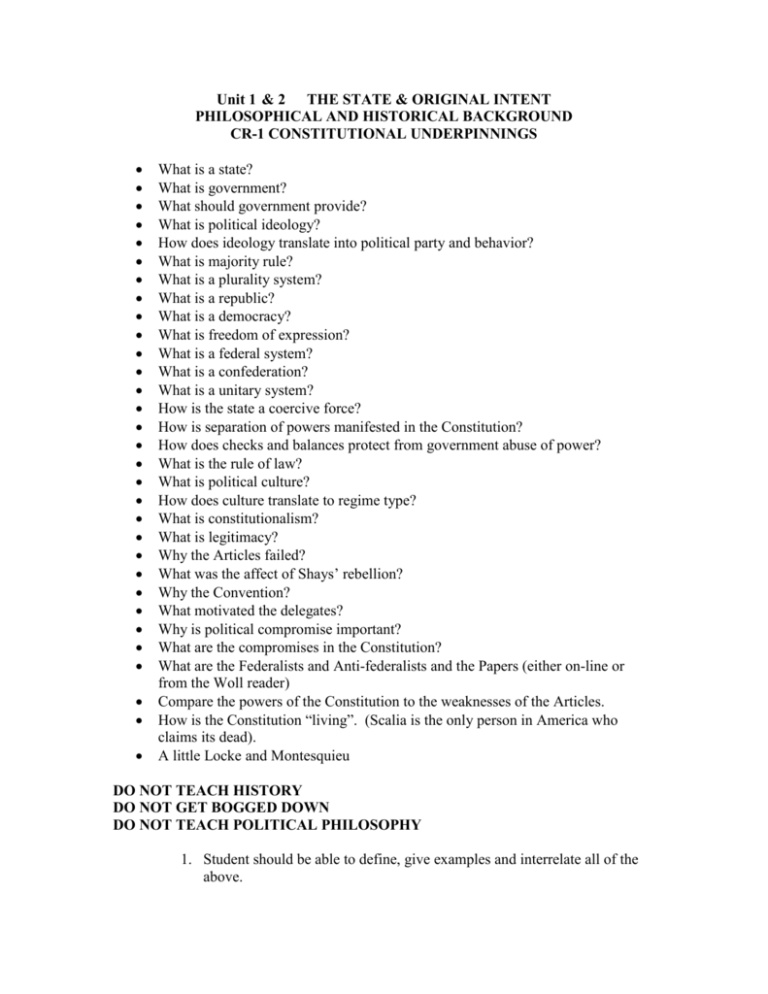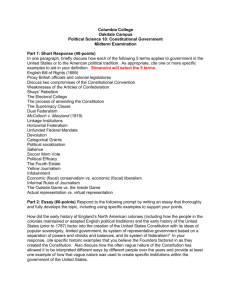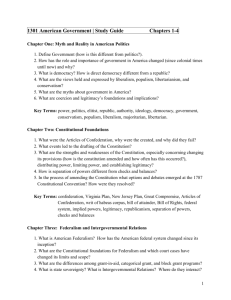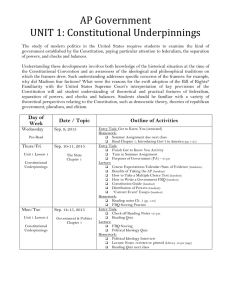Unit 1 & 2 THE STATE & ORIGINAL INTENT PHILOSOPHICAL AND
advertisement

Unit 1 & 2 THE STATE & ORIGINAL INTENT PHILOSOPHICAL AND HISTORICAL BACKGROUND CR-1 CONSTITUTIONAL UNDERPINNINGS What is a state? What is government? What should government provide? What is political ideology? How does ideology translate into political party and behavior? What is majority rule? What is a plurality system? What is a republic? What is a democracy? What is freedom of expression? What is a federal system? What is a confederation? What is a unitary system? How is the state a coercive force? How is separation of powers manifested in the Constitution? How does checks and balances protect from government abuse of power? What is the rule of law? What is political culture? How does culture translate to regime type? What is constitutionalism? What is legitimacy? Why the Articles failed? What was the affect of Shays’ rebellion? Why the Convention? What motivated the delegates? Why is political compromise important? What are the compromises in the Constitution? What are the Federalists and Anti-federalists and the Papers (either on-line or from the Woll reader) Compare the powers of the Constitution to the weaknesses of the Articles. How is the Constitution “living”. (Scalia is the only person in America who claims its dead). A little Locke and Montesquieu DO NOT TEACH HISTORY DO NOT GET BOGGED DOWN DO NOT TEACH POLITICAL PHILOSOPHY 1. Student should be able to define, give examples and interrelate all of the above. 2. Use multiple examples for the terms and make connections between the terms. 3. Use comparative political systems (regime types) to draw associations and differences. 4. Examples should be vivid—Nazis, Fascists, communists, Maoists 5. Country examples could include: Myanmar, China, Venezuela, Cuba, Russia, Japan, Iran, Iraq, Saudi Arabia, France 6. You should read Essentials of Comparative Politics 2nd ed., Patrick O’Neil, Norton ISBN-13: 978-0-393-92876-1. (If your school is teaching the Comparative Course this should be ONE of the basic texts for the course. Unit 3 THE CONSTITUTION CR-1 CONSTITUTIONAL UNDERPINNINGS 5-15% What does the constitution do? What are the three structures of government? What are the formal powers of each branch and examples? What are the checks and balances and separation of powers? How is impeachment political? How does judicial review work? What is original intent? What is congressional elaboration? How does appointment and confirmation work? How does the veto work? How does federalism work? What are the powers laid out in the constitution? How is the Constitution changed? Unit 4 FEDERALISM CR-1 CONSTITUTIONAL UNDERPINNINGS 5-15% What are the characteristics of federalism? What is good about federalism? How are powers shared? What is the role of the Supremes in federalism? Bush v Gore 2000. The supremacy clause---McCulloch v MD. The interstate powers—Heart of Atlanta v US The inherent powers Curtiss Wright Export v US Reserved and concurrent powers of states Preemption, federal mandates, unfunded mandates, state administration of federal programs Horizontal federalism Centrists & de-centrists; republicans, democrats Grants-in-aid Cooperative federalism, new federalism, marble cake theory, layer cake theory









